Due to the characteristics of low volatility, low cost and strong liquidity, short-term debt funds are very popular with investors who have higher requirements for liquidity, lower requirements for income or risk-averse investors.
In fact, in the current market environment with loose funds and low interest rates, the returns of short-term debt funds are still very good. The author found several different types of short-term debt funds to communicate with you.

1. Short-term debt and short-term debt funds
Short-term debt funds are an important branch of pure debt funds.
Short-term debt is generally divided into ” ultra-short-term debt ” and ” short-term debt “.
Ultra-short-term bonds are bonds with a maturity date within 1 year; medium- and short-term bonds are bonds with a maturity date of 1-3 years;
Short-term debt funds are generally distinguished by their names according to the type of short-term debt they invest in, such as “Shanxi Securities Ultra-short-term Bond A”, “Huaxia Medium- and Short-term Bond A”, and “Guangfa 1-3 Year CDB Bond A” mentioned in the table above. “Wait;
From the performance comparison benchmark or tracking index of bond funds, it is also possible to directly determine whether a bond fund belongs to “long-term debt”, “short-term debt” or “ultra-short-term debt”.

Among the 7 funds in the table above, only 2 are ultra-short-term debt funds, and the other 5 are short-term debt funds.
The investment scope of short-term debt funds
Short-term debt funds are an important branch of pure debt, so they are no different from pure debt in terms of investment scope.
It is just that short-term debt funds have better liquidity and safety than ordinary pure debt funds, but may sacrifice a certain amount of income, because the interest rate level of short-term bonds is usually lower than that of long-term bonds.
Each fund has the definition of its investment scope. The investment scope of short-term debt funds is almost the same between different funds.
Take the investment scope described in the prospectus of ” Shanxi Securities Ultra-short-term Bond A ” as an example:
” The Fund invests in financial instruments with good liquidity, including treasury bonds, local government bonds, central bank bills, financial bonds, corporate bonds, corporate bonds, medium-term notes, short-term financing bills, ultra-short-term financing bills, publicly issued subordinated bonds , small and medium-sized private placement bonds, short-term corporate bonds of securities companies, pure debt portion of detachable convertible bonds, asset-backed securities, bond repurchase, bank deposits, interbank certificates of deposit, money market instruments, treasury bond futures and other laws and regulations or the China Securities Regulatory Commission Other financial instruments that the fund is allowed to invest in, but must comply with the relevant regulations of the China Securities Regulatory Commission. The fund does not invest in stocks, warrants and other assets, nor in convertible bonds (except for the pure debt part of detachable convertible bonds), Exchangeable bonds.”
Pure debt funds will clearly stipulate in their investment scope that they will not invest in equity assets such as stocks and warrants, as well as convertible bonds and exchangeable bonds with rights-bearing assets.
3. When to invest in short-term debt funds
The answer is given in Snowball Platform’s recently published ” Snowball Fund Lesson 1 “.
In Chapter 2 of the book, ” Should you choose a short-term or medium-long-term pure debt fund ” section, there is the following description:
“When should I choose a short-term pure debt fund, and when should I choose a medium- and long-term pure debt fund? One technique is to look at the current market interest rate. If the market interest rate is low, choose a short-term pure debt fund, and if the market interest rate is high, choose a long-term pure debt fund .
Because when interest rates are high, the probability of future declines is greater. Once interest rates fall, bond prices rise, and bond fund yields rise with it. Long-term bonds are more sensitive to interest rates, so they will rise higher than short-term bonds, so it is suitable to invest in long-term bonds when interest rates are high; conversely, when interest rates are low, it is more suitable to invest in short-term bonds.
For the judgment of interest rates, you can refer to the ten-year Treasury bond yield. The yield of my country’s 10-year treasury bond is around 3.5%. When the ten-year treasury bond is above 3.5%, the interest rate is high and the downside is large, which is suitable for investing in medium and long-term bonds; otherwise, short-term bond funds are invested.”
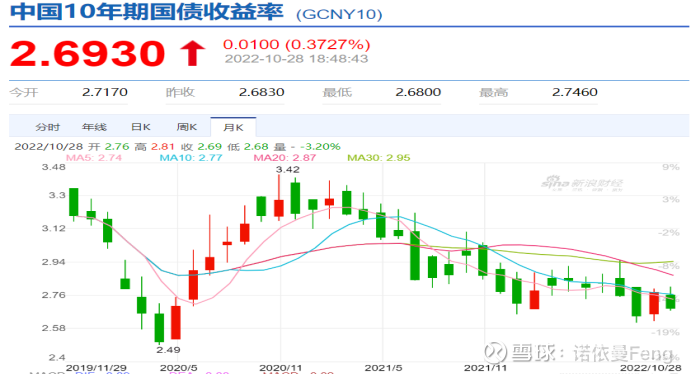
4. Share excellent short-term debt funds
1. The overall performance of short-term debt funds
The CSI Short-Term Bond Index (H11015) is selected as the benchmark for performance comparison of short-term bond funds.
The performance of the 7 funds outperformed the CSI Short-Term Bond Index at all stages.
The performance returns of the 7 funds this year (YTD) have all exceeded 3%, and the performance benchmark for the same period is 2.20%. Among them, ” Zhongrong 1-3 years medium and high grade A ” has the best performance, with a performance return of 3.56%; the best performance in the past year It is also ” Zhongrong 1-3 years medium and high grade A “, with a performance return of 4.60%; the fund is an index fund, and the benchmark index is “Shanghai Clearing House 1-3 years middle and high grade credit bond index”.
The best performance in the past two years is ” Galaxy China Bond Central Enterprise 20 “, with a cumulative performance return of 8.67% in the past two years. The fund is also an index fund, and the benchmark index is “ChinaBond-1-3 Year Duration Central Enterprise 20 Bond Wealth (Total Value) Index”.
The best performance in the past three years is ” Shanxi Securities Super Short-Term Bond A “, with a three-year cumulative performance return of 12.27%. The fund is an ultra-short-term debt fund. The three-year cumulative excess return is 3.86%, which is basically the average return of the short-term debt fund in one year, and it can be considered that it has obtained four years of returns in three years.
The CSI Short-Term Bond Index has risen by 8.41% in three years. 7 short-term debt funds have three-year cumulative returns of more than 10%; only one “Shanxi Securities Short-term Bond A” exceeds 12%; four are more than 11%, namely Zhongrong 1-3 years medium-high grade A, CITIC Securities 6 Monthly rolling holding A, Galaxy China Bond Central Enterprise 20, Huaxia Medium and Short-term Bond A; 2 are over 10%, namely Huabao Medium and Short-term Bond A, GF 1-3 Year CDB Bond A;

2. Maximum drawdown
Most of the investors who buy short-term bond funds are stable investors or risk-averse investors, who are more sensitive to the fluctuation of funds;
One of the characteristics of short-term bond funds is that they are less volatile than ordinary bond funds.
The reasons for the fluctuations in the net value of bond funds are, first, that changes in interest rates affect bond prices;
The chart below shows the net worth trend of seven short-term debt funds in the past three years. From the net value curve of each fund, we can clearly see the fluctuation of the fund, such as the large fluctuation between April and June 2020;
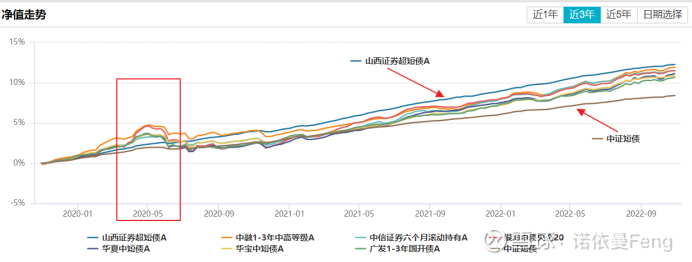
At the same time, we also see a blue line in the figure. The volatility in each period is very small, almost a straight line that slopes upward. This straight blue solid line is ” Shanxi Securities Ultra-short-term Bond A “.
The author counted the largest drawdowns of 7 funds in each period:
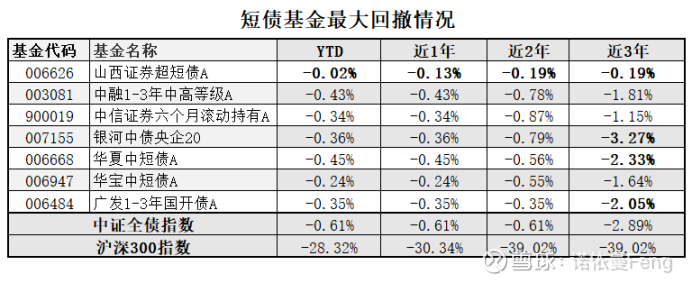
“Shanxi Securities Super Short-Term Bond A” has the largest drawdown this year of -0.02%, which is almost negligible, and the largest drawdown in three years is only -0.19%; the fund was established on January 21, 2019, and the largest drawdown since its establishment is also is -0.19%; it is a bond fund that “draws a straight line” .
Another “ultra-short-term bond” fund “CITIC Securities 6-month rolling holding A” has the largest three-year drawdown of -1.15%, which is the smallest except for Shanxi Securities’ ultra-short-term bond A;
The volatility of other “short- and medium-term debt” funds is relatively high. The three-year volatility of “Galaxy China Bond Central Enterprise 20” with the highest rate is as high as -3.27%, which is almost equivalent to a drop in the annual increase in one day. In other words, this volatility is a bit “excessive”.
What is the reason for the low volatility of “Shanxi Securities Ultra-short-term Bond A”?
Let’s first look at the bond asset allocation and position concentration of each fund.
3. Asset allocation
(1) Coupon type configuration
GF 1-3 year CDB Bond A is all allocated financial bonds ; the other 6 funds are mainly credit bonds (corporate bonds, corporate short-term financing bills, and medium-term notes).
Among the 7 funds, “CITIC Securities 6-month rolling holding A” and “Huabao short-term bond A” did not use leverage, and the other 5 funds had to use leverage to varying degrees to enhance returns. The two index bond funds “Zhongrong 1-3 Years Mid-to-High Grade A” and “Guangfa 1-3 Years CDB Bond A” have high leverage ratios, and bond holdings account for more than 130% of their net assets.
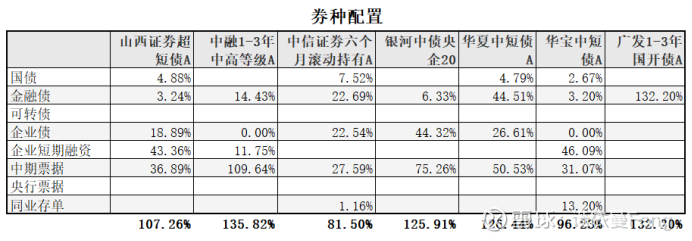
(2) Top five heavyweight bonds
The position concentration of the 7 funds is very different.
The net value of the top five bonds of Shanxi Securities’ ultra-short-term bond A accounted for 6.84%, and the positions were very scattered ; and the positions were balanced, and the top five positions accounted for 1.23%-1.66% ; The net value of the five major bonds accounted for 53.52%, and the positions were very concentrated;
CITIC Securities, which is also an ultra-short-term debt fund, holds A on a rolling basis for six months, and its holdings are relatively scattered. The five largest holdings total 16.98%, and the single highest is 4.14%, not exceeding 5%;
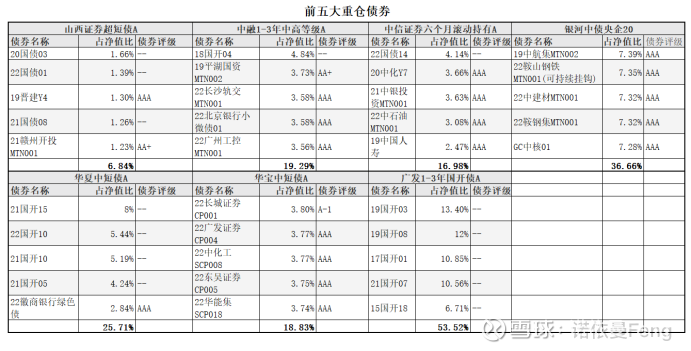
》Decentralized and balanced bond holdings should be one of the main reasons for the low volatility of Shanxi Securities’ ultra-short-term bond A;
” In the prospectus of Shanxi Securities’ ultra-short-term bonds A, it is stipulated that “ the ultra-short-term bonds invested by the Fund refer to bond assets with a remaining maturity of not more than 270 days , mainly including government bonds, local government bonds, central bank bills, financial bonds, corporate bonds, Corporate bonds, medium-term notes, short-term financing bills, ultra-short-term financing bills, publicly issued subordinated bonds, private placement bonds of small and medium-sized enterprises, short-term corporate bonds of securities companies, and the pure debt portion of detachable convertible bonds. The short remaining maturity of the bonds is also one of the main reasons for the low volatility of Shanxi Securities’ ultra-short-term bond A.
4. Holder structure
The three index-type short-term debt funds, Zhongrong 1-3 Years Medium and High Grade A, Galaxy China Bond Central Enterprise 20, and GF 1-3 Years CDB Bond A, are mainly held by institutions, with institutional holdings accounting for more than 99%;
China AMC Short-Term Bond A is the largest of the seven funds, with a fund size of 16.589 billion yuan, more than the sum of the other six, and the fund’s institutional holdings amount to 97.11%;
The six-month rolling holding of A by CITIC Securities is basically personal holding, accounting for 99.97%;
The ratio of individual holdings and institutional holdings of Shanxi Super Short-term Bond A and Huabao Medium and Short-term Bonds is almost the same.
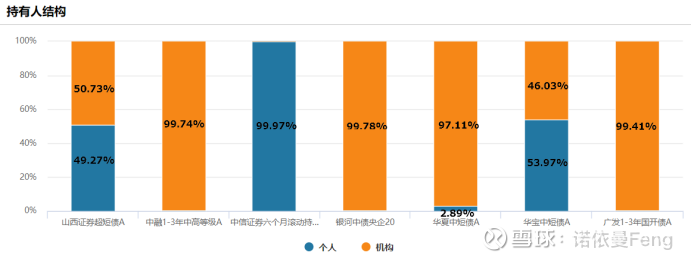
5. Fund fees
Fund fees are generally divided into three categories: daily fees, subscription rates, and redemption rates .
(1) Daily expenses , including management fees, custody fees, and sales and service fees . The daily expenses are directly deducted from the daily net value in the process of fund operation. The net value of the fund we see is the figure after deducting these expenses; so these expenses affect the net value, that is, our daily income. Directly focus on net worth, you can ignore these fees.
The sales service fee generally corresponds to the subscription/redemption fee ; if the sales service fee is charged daily, the subscription/redemption fee will not be charged. This is also the difference between Class A shares and Class C shares of the fund. Because of this, it is generally believed that Class A shares are suitable for long-term holding, and Class C shares are suitable for short-term holding.
The charging method of “CITIC Securities’ six-month rolling holding of A” shall be charged in accordance with the method of Class C shares of the fund. Sales service fees are charged, but subscription/redemption fees are not charged (the fund’s name is already reflected, and its minimum holding period is 6 months). The other 6 funds do not charge sales service fees.
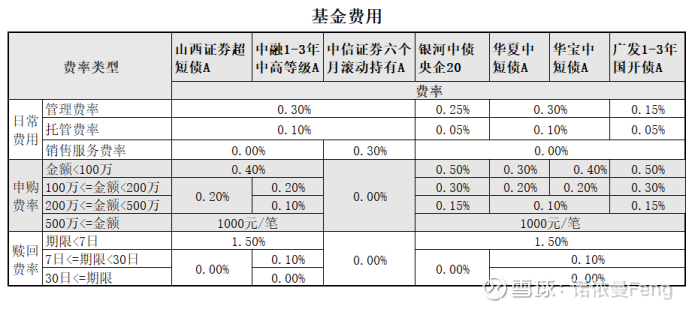
(2) The subscription fee is charged at one time when the fund is purchased . If it is a new fund, it is called “subscription fee”; the subscription (subscription) fee is charged according to the number of fund shares purchased. The more you buy, the lower the cost.
The subscription fee is a one-time payment, and the level of the fee requires investors to pay extra attention when purchasing.
For most ordinary investors (less than 1 million yuan at a time), among the 6 funds (excluding CITIC), the lowest subscription fee is Huaxia Medium and Short-Term Bond A, 0.30%; Galaxy and GF are both 0.50%; the other 3 only 0.40%;
(3) The redemption fee is charged at one time when the fund is redeemed . This also requires additional attention from investors. However, debt funds are basically in a “more lenient” state for redemption, and they can be redeemed for free if they are held for 7 days or more than 30 days.
Redemption within 7 days of holding is charged a redemption fee of up to 1.5%, which is actually similar to a “punitive clause”.
6. Morningstar three-year rating
The Morningstar 3-year ratings of the 7 funds are all four-star and five-star.
The three five-star rated funds are not only the three with the highest three-year cumulative return, but also the three with the smallest fund volatility (maximum drawdown) (Zhongrong’s largest three-year maximum drawdown is slightly larger than Huabao, ranking 4th)
In the net worth growth this year and the past year, Zhongrong ranked first in the middle and high grade A in 1-3 years
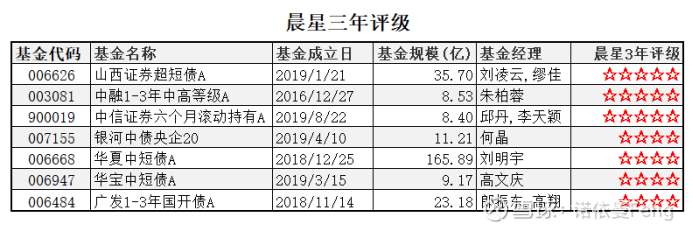
From the perspective of personal preference, in addition to the above three five-star ratings, add Huabao’s short-term debt.
(End of full text)
( Note: 1. The content of this article only represents my own views and can only be used for reference. It does not constitute investment advice, and cannot be used as a recommendation or guarantee for buying, selling, subscribing securities or other financial instruments. 2. Comments, corrections, and discussions are welcome. 3. Data and data sources: Wind Financial Terminal; Morningstar Fund Network; Sina Finance)
@雪ball Creator Center @Today’s topic @雪ball fund @ golf friend welfare # Snowball star plan public offering master# $Zhongrong 1-3 years medium and high-grade credit bond A(F003081)$ $Huabao medium and short-term debt bond A( F006947)$ $China AMC Medium and Short-Term Bond A(F006668)$ @Snowball Fund Lesson 1
This topic has 0 discussions in Snowball, click to view.
Snowball is an investor’s social network, and smart investors are here.
Click to download Snowball mobile client http://xueqiu.com/xz ]]>
This article is reproduced from: http://xueqiu.com/3179670287/234014566
This site is for inclusion only, and the copyright belongs to the original author.